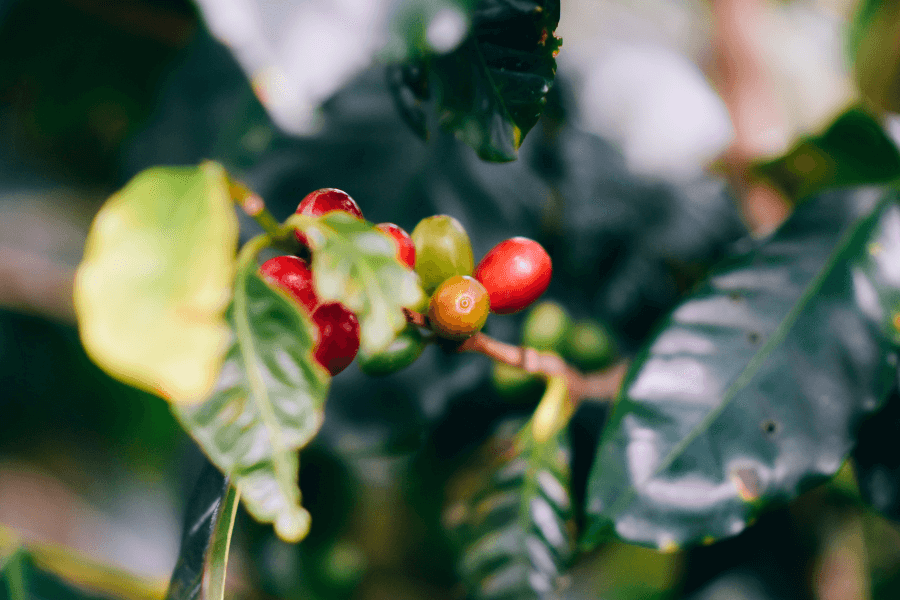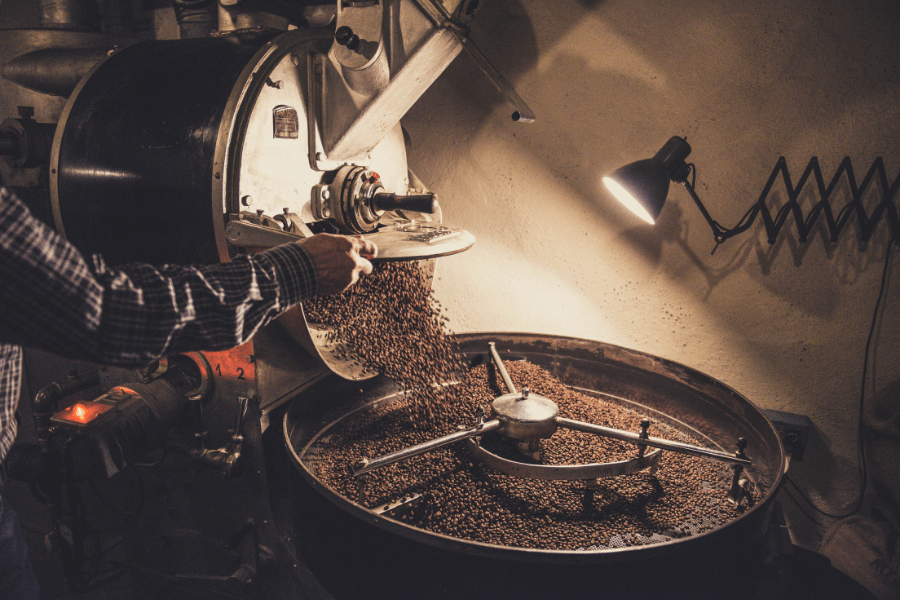How Coffee is Made: A Step by Step Look
It’s easy to forget that coffee is a commodity that undergoes a lengthy and complex process before reaching your kitchen. Considering how easy it is to enjoy a cup of joe, (as most commercial coffee brands are produced with convenience in mind), you may be surprised at how much effort goes into manufacturing coffee.
I love cool facts almost as much as I love coffee, so I’ve combined the two to bring you an inside look at how coffee is made. You may come to appreciate your joe even more once you’ve seen how it’s produced.
Where Does Coffee Come From?
Before we get to the coffee-making process, we have to go back to square one: the origins of coffee.
For the full story, check out my article on where coffee beans come from, but for now, here’s the short version.
How is Coffee Made?
Coffee as we know it comes from the coffee plant. This flowering, tree-like shrub bears fruit, the seeds of which are dried and roasted to become grounds. I’ll cover the processing steps involved in producing coffee later in this article.
There are varying data on the matter, but most reports state that there are between 100 and 120 different coffee species, each with its own flavor profile. However, the vast majority of commercial coffee stems from only four types: Arabica, Robusta, Liberica, and Excelsa.

Where Does Coffee Originate From?
Coffee was discovered more than a thousand years ago in Ethiopia — Arabica coffee’s native land. It was a much-loved energy drink, but it only spread beyond its home country from the 15th century onward, it rose in popularity throughout the western world in the 17th century.
The second most popular type of coffee, Robusta, also originates in Africa, having been discovered in what was then the Belgian Congo.
Which Countries Produce Coffee?
Coffee is predominately harvested in an area known as the bean belt. This strip, located between the Tropic of Cancer and the Tropic of Capricorn, offers the perfect growing conditions for coffee plants (no matter the species) to thrive. It’s difficult, but not impossible, for countries outside the bean belt to produce coffee.
The bean belt includes areas of Africa, South and Central America, and Asia. The top ten coffee producers in the world all fall within this zone. According to WorldAtlas, these are:
- Brazil
- Vietnam
- Colombia
- Indonesia
- Ethiopia
- Honduras
- India
- Uganda
- Mexico
- Guatemala
How Coffee is Produced
Coffee production may sound simple (pluck, dry, roast), but it’s a complex and time-consuming process. Not to mention the many variables in coffee processing methods, for example, the species of plant being cultivated and the target flavor profile.
Here’s a step-by-step process of how coffee is made.
Step One: Growing Coffee Plants
It all starts with cultivation — by no means a simple task. Generally speaking, coffee plants are temperamental and perfect conditions are required; it can take years for plants to yield any fruit at all.
Let’s take a quick look at growing the four main varieties.
Arabica
Arabica plants can take up to six years to reach their fruit-bearing stage, and keeping them alive is an art form. These plants are extremely fussy and won’t thrive if planted in unfavorable environments. They’re also disease-prone, and entire crops are at risk if plantations are infected.
High altitudes are ideal for Arabica, and it grows best in the shade, in cool to mild regions with regular rainfall.
Robusta
Far hardier than Arabica, Robusta can survive almost anything. It resists disease thanks to its high caffeine content, won’t wilt if it’s planted in unfavorable conditions, and doesn’t require as much pruning or TLC.
Still, there are ideal conditions that enhance Robusta coffee’s flavor profile. This plant flourishes in arid climates at low altitudes and can withstand much warmer temperatures than Arabica. One drawback though, is that needs a lot more water.
Liberica
It may not be as popular as Arabica or Robusta, but Liberica still ranks among the top commercial coffees in the world. Like Robusta, it’s a hardy plant that tolerates unfavorable conditions including acidic soil, variations in climate, and even droughts.
It’s a tropical plant that will thrive at low altitudes, in mild to hot temperatures, with somewhat regular rainfall.
Excelsa
Excelsa coffee plants are a bit of an anomaly because botanists and agriculturists can’t seem to decide what family it belongs to. Some say it’s part of the Liberica family while others are adamant that it’s too different to be grouped as such.
Currently, it’s considered a Liberica variant, and its ideal conditions are similar: low altitudes, mild to hot temperatures, and regular rainfall.

Step Two: Harvesting Coffee Beans
With the exception of Arabica, coffee plants yield fruit within four years of being planted. Cultivators know coffee fruit is ripe when it turns from green to red. In the majority of countries, there’s only one harvest per year, though some plantations have secondary crops that yield a second harvest.
Some plantations pick coffee berries by hand, while others use specialized machines. Take a look at this video to see them in action:
All plantations use one of two picking methods to harvest coffee fruit.
Strip picking is when coffee fruit is pulled off of coffee plants indiscriminately, leaving no fruit behind, whether they’re good enough to process or not. The fruit is pulled off branches one by one and sorted later. Strip picking can be achieved manually or by machines.
Selective picking, on the other hand, can only be done by hand because only the coffee fruit deemed good enough for production is plucked. These are usually the ripest coffee berries. Because of the labor required, selective picking is far more time-consuming, costly, and usually reserved for sought-after beans like Arabica.
Harvesting coffee fruit can take up to 90 days, depending on the size of the plantation.
Step Three: Preparing Coffee Beans
Once coffee fruit is picked, it has to be processed quickly and efficiently or else it spoils. There are two coffee processing methods typically determined by the plantation’s location or climate and the available resources.
Wet Processing
In this method, coffee berries are put through a pulper that removes the fruit’s flesh from its seeds, leaving only a thin layer of skin, the parchment (also called the pergamino) around the seeds.
The seeds are then put through a water channel that separates them by weight. Smaller seeds float while larger and heavier seeds sink. They’re then grouped once more, passing through drums that sort them by size.
Next, the seeds are placed in large water tanks and left to ferment. This can take anywhere from 12 hours to two days. While fermenting, slime and other impurities dissolve. Finally, the seeds are rinsed off and dried.
Wet processing is the more efficient of the two hulling methods as it uses machines, but it requires a lot of water and more room.
Dry Processing
When wet processing isn’t a viable option, the dry coffee processing method is the alternative. Here, the seeds are not removed after plucking. Instead, whole berries are spread out and left to dry in the sun.
To prevent over-processing, human intervention is necessary. The berries have to be turned frequently and must be protected from rain and moisture.
The fruits are deemed ready when their moisture level reaches approximately 11%. The seeds are then separated from what’s left of the fruit, typically with the help of machines. The dry method is the original coffee-making process.

Step Four: Milling the Coffee
Once coffee seeds have been stripped and dried, they go through mills that prepare them for export. Here, coffee seeds go through three stages.
1. Hulling
Wet-processed seeds are run through hulling machines that remove the unnecessary parchment skin from the coffee bean.
2. Polishing
Sometimes coffee beans are run through an additional machine to remove any parchment, skin, or husk that’s still present. Not all coffee beans are polished. It’s an extra step that makes little difference, though many consumers prefer polished beans as they’re perceived as higher quality than their unpolished counterparts.
3. Grading
Finally, coffee beans are screened for quality. Here, the beans are sorted according to size and weight and inspected for color and integrity. Damaged, defective, or inadequate beans are removed and discarded. Beans are also graded at this stage.
This final coffee processing step is completed manually or with machines. Most plantations use a combination of the two.
Step Five: Export
Once the best coffee beans have been sorted, they’re ready to leave the plantation. Green coffee beans, as they’re known at this point, are packed into bags or sacks, loaded onto shipping containers, and exported.
Step Six: Sampling
Once processed coffee beans arrive at their destination, they’re put to the test. Known as cupping, the coffee is sampled and inspected for quality. The sampler is known as a cupper and they have an interesting job indeed.
First, the cupper assesses the appearance of the beans. Then, they take a few for testing, roast them, and immediately grind and brew these beans. These steps are strictly controlled for consistency.
Before tasting the coffee, the cupper will evaluate its aroma first. After leaving the coffee to rest for a few moments, the cupper will judge the aroma again, then quickly have a taste — usually no more than a spoonful.
The testing phase regulates a coffee’s profile and quality, which is not only helpful to consumers, but to manufacturers as well. Cuppers’ assessments help determine which beans are good for which roasts, and which ones are best for blends.
Step Seven: Coffee Roasting
This is the defining coffee processing step that turns simple seeds into coffee as we know it. During roasting, beans are exposed to temperatures as high as 550 degrees Fahrenheit. Manufacturers use machines that are safe for use with such extreme heat and keep the beans moving so they don’t burn.
Roasting released caffeol, an oil that gives coffee its aroma and flavor profile. Once ready, the beans are cooled immediately. At this point, the fresh, whole beans are ready to be sold.

Step Eight: Grinding Coffee
The final coffee processing step is to grind the beans according to the intended use. Beans produced for espresso are ground much finer than those made for drip coffee makers, for example. Grinding methods are determined by the manufacturers.
Fun fact: Instant coffee is a dehydrated coffee concentrate. This is the only extra step in its production, otherwise, it’s prepared the same as any other coffee.
Step Nine: Packaging and Wholesale
Each manufacturer approaches this coffee processing step differently. Some send their fresh coffee off to markets, wholesalers, or grocers. Others package and brand the coffee themselves, then sell directly to retailers, who then sell the product to consumers like you and me.
Step Ten: Brewing
It all boils down to this — literally! Whether you enjoy your coffee at home, buy it from a cafe, or delight in craft brews, brewing is what ties it all together. The aromas, flavors, and qualities engineered in the roasting process are unleashed when your grounds are infused with water (or milk). The only thing left to do is sit back and savor the brew.
Conclusion
Now you know how coffee is made, and as you can see, it’s not a simple or easy process. The commercial coffee-making process requires immense time, resources, labor, and land to meet consumer demand.
It’s no surprise when you consider that after crude oil, coffee is the most in-demand commodity in the world.
Which of the coffee processing steps surprised you? Are there any hidden secrets of the trade that I may have missed? Drop a comment and let me know!
Don’t forget to share this article with your fellow enthusiasts. They’ll appreciate their coffee more, and I’ll appreciate the support.
How Coffee Is Made FAQs
Is the Coffee Industry Bad for the Environment?
It depends on the coffee-making process. As explained above, the dry processing method uses far less water and electricity and is, therefore, kinder to the earth. Wet processing, on the other hand, requires tons of resources and machinery and isn’t the greenest choice.
That said, the increased global demand for coffee means that large tracts of land are cleared for cultivation, and deforestation can have devastating effects on natural ecosystems. Additionally, soil is a finite resource that requires care to keep it in good condition. This level of care can fall by the wayside when producers prioritize profit over sustainability.
Coffee’s eco-credentials also vary by type. Espresso is said to have one of the largest carbon footprints, while instant coffee has a reputation as the most eco-friendly.
If you’re worried about your own bean habit’s effect on the environment, choose ethical and sustainable small-batch producers such as Tiny Footprint Coffee. Read our short review of these organic coffee beans here.
Is Coffee Organic?
Coffee is certainly natural, but it’s not always organic. Some plantations make use of chemical fertilizers, pesticides, and other additions. The only way to know if the coffee you drink is organic is to research the manufacturer.
How Much Coffee Is Produced Every Year?
Billions of pounds of coffee are exported annually. The International Coffee Organization reports that roughly 81 million bags of Arabica coffee were exported between February 2020 and February 2021. More than 10 million bags of coffee were exported in February 2021 alone.
Is the World’s Coffee Running Out?
Some coffee species are endangered, largely due to habitat loss and climate change. However, this doesn’t mean that we are running out of coffee just yet. All reports on the matter explain that these species (Arabica included) are being threatened with extinction in the wild.
We should absolutely make an effort to conserve them, but it doesn’t look like the industry has taken many knocks because of this burgeoning crisis.
Does the Coffee Industry Use Slave Labor?
The coffee industry is no different from any other high-demand industry. Reuters reports that Brazil’s plantations in particular have unfair labor conditions, so it is a real problem. However, it’s important to understand that not all plantations are guilty of exploitation, and the coffee industry is not inherently evil.
Choose brands and producers that have a demonstrated dedication to ethical, fair, and sustainable practices.





